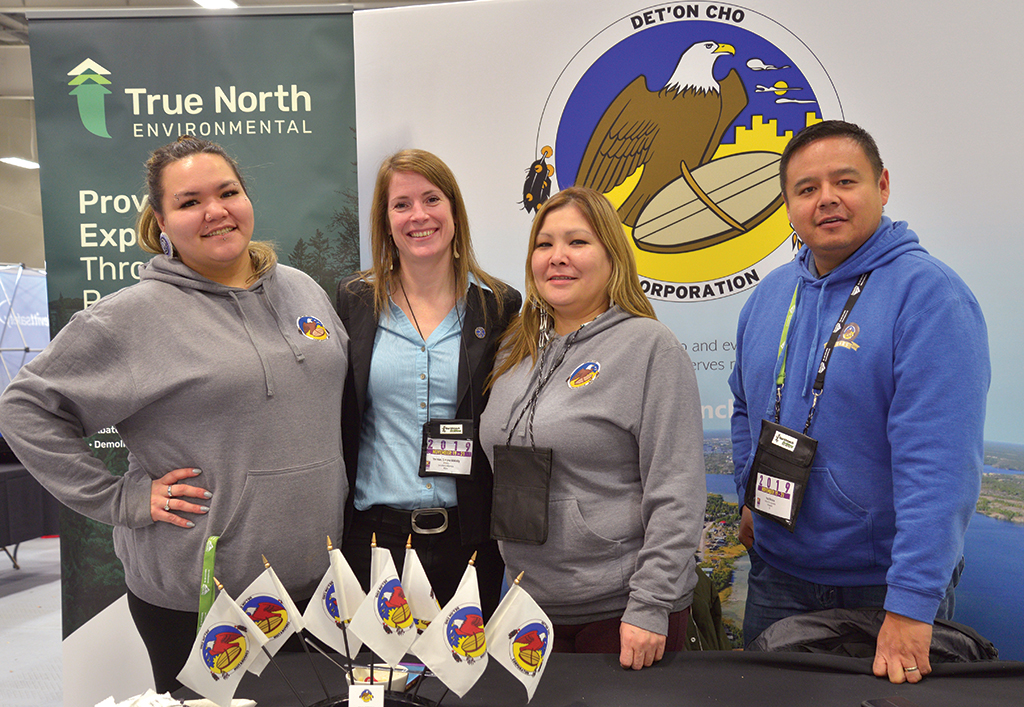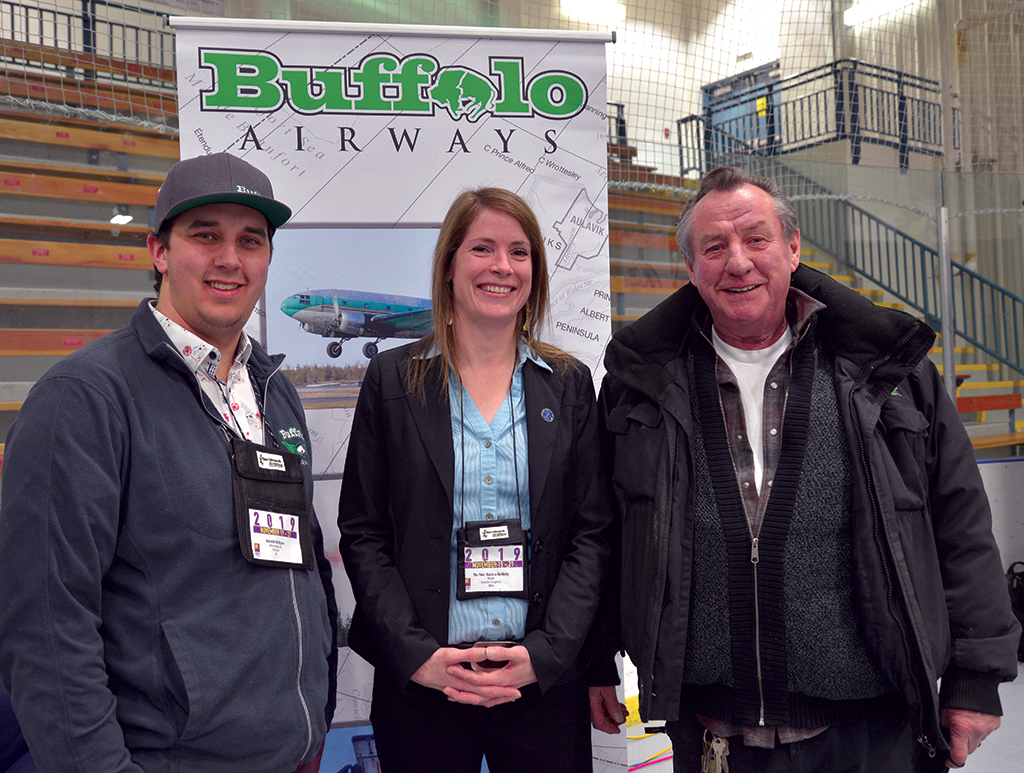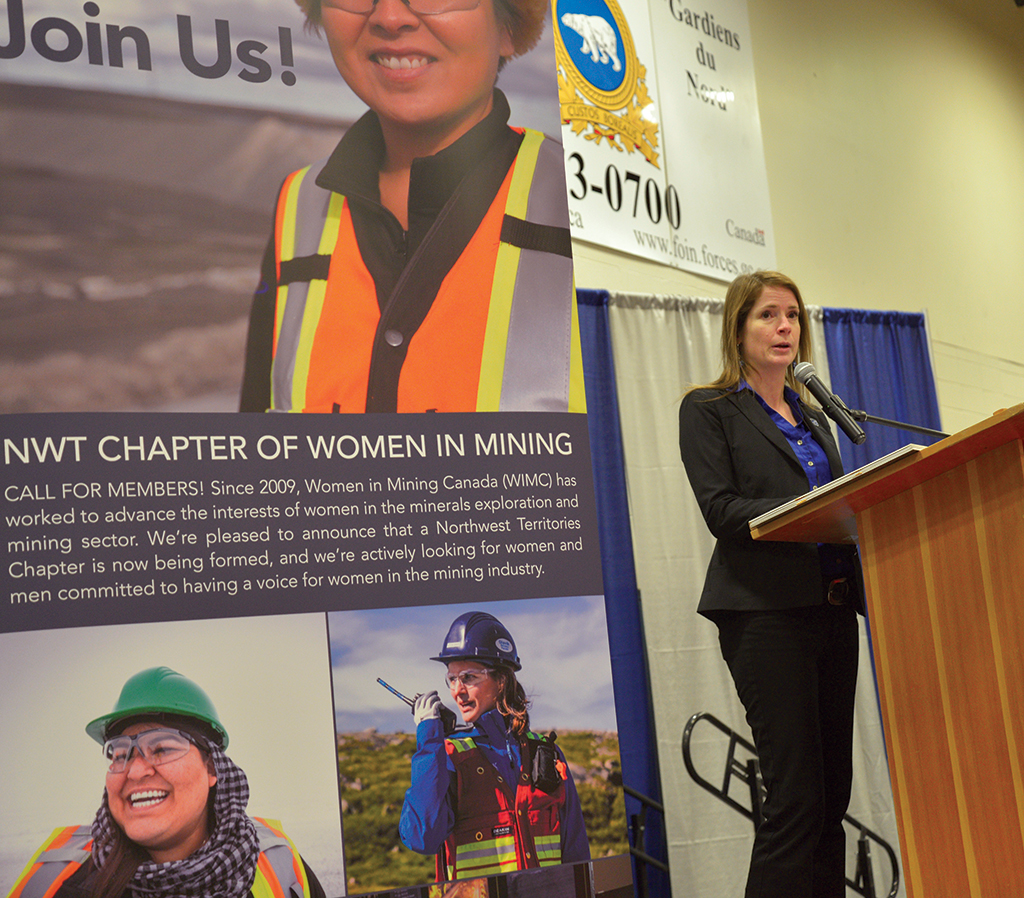One-on-one with
Katrina
Nokleby

As the new decade dawns on the NWT, a new government has taken the reins of the territory following an historic election that saw residents elect an Assembly of representatives with virtual gender parity. Part of that new leadership team is Minister Katrina Nokleby who is now the minister responsible for the departments of Industry, Tourism and Investment, Infrastructure, and, Workers’ Safety and Compensation Commission.
Q: How do you think your previous vocation as a Geological Engineer will benefit you in your new dual role as Minister of Industry, Tourism, and Investment as well as Minister of Infrastructure?
A: My background as an engineer brings a lot of knowledge and experience to these portfolios. I understand how important infrastructure is to all of our communities, including the role that infrastructure plays in helping us achieve so many of our priorities in areas across government. I also have experience in environmental engineering and northern project management, which I know will serve me well as Minister of Infrastructure.
I have spent a lot of my life traveling, being a tourist and learning and have seen firsthand some of the challenges running a small tourism business entails – particularly in the North. I am confident that the experiences I gained during that period in my life will continue to prove useful in my role as Minister of Industry, Tourism and Investment.
On a more personal level, I am engaged in the community and committed to life in the NWT and making the North a better place for the people in it. The departments of INF and ITI, in particular, have a lot of big projects on the go – Taltson, Slave Geological Province, efforts to increase our tourism industry, oil, and gas, etc. There is plenty of engagement left to do, work to undertake and partnerships to be strengthened to get these projects moving. I am confident that my experience and desire to see these projects progress will help as I work to lead the department throughout this next Assembly.
Q: The 2019 election was certainly a historic one for the NWT. How do you feel to be a part of the first territorial government that has gender parity and how do you think residents and the territory could benefit from this new benchmark in representation?
A: I think that the new territorial government is the reflection of an incredible evolution in our territory. With a record number of women elected, we’re now an example to the rest of Canada, as we have the highest proportion of women legislators in our country – including a majority of women represented in Cabinet, including the only female premier in the country.
As a female engineer who has spent most of my career in a traditionally male environment, this is a point of personal pride and satisfaction. The absence of female leadership and political role models was a big part of why I decided to run for office. I have said it a few times since being elected, but it’s true, that for the first time in a long time, I can tell you it’s nice not to be outnumbered on my jobsite.
Q: Your new profession also positions you to be a role model for female students and women working in non-traditional roles. Will this have an impact on how or what you do over the next four years?
A: Even before I was in politics, I recognized the need to have role models for young women today. It has always been a passion of mine and I intend to carry this passion through in the work that I am doing over the next four years. I don’t know yet what exactly that looks like, but I will be working with staff in my departments to find creative ways to ensure young women and girls are given opportunities for success and that I can continue to be a role model for all young people, over the next four years.

Photo courtesy of the NWT & Nunavut Chamber of Mines.
Q: Under Premier Bob McLeod, the GNWT and Indigenous governments jointly identified the importance of – and declared their support for – resource development. How will your government look to build on this initiative or alternatively, chart a new course?
A: Increasing resource exploration and development is a priority for the 19th Legislative Assembly that Cabinet will be addressing as part of our government’s mandate.
As you know, the Government of the Northwest Territories has a history of leading the way when it comes to partnerships and Indigenous participation, and this government is equally as committed to this.
With a balanced and meaningful approach to partnerships, resource investment and local economic development the GNWT believes that it can realize the economic strength and diversity our territory needs to improve and sustain the quality of life that its residents expect and deserve.
Q: What is the role of Indigenous governments and their organizations in advancing resource exploration and development in the territory?
A: The role of Indigenous governments is an incredibly important one. Indigenous governments own significant amounts of land in their regions that may have resource potential and could stand to benefit directly from the development of these resources.
They are our partners in defining how resource development is going to happen across the territory and ensuring it reflects our values. They are leaders in local contracting and employment and active participants in exploration and mining, and, most importantly, are advocates and the means by which we keep benefits from mining and exploration in our territory.
The GNWT wants to make sure that Indigenous governments remain active partners and continue to benefit from our resources. Things like resource revenue sharing, participating in our co-management regulatory boards, etc. are all important and, as we look to the future, I’d like to see Indigenous governments play an even larger role. I think we’re on the right track to see that happen.
Q: What do you think is the biggest misconception about resource development in the North that you would like to set straight?
A: I think one of the misconceptions is the idea that Indigenous governments and communities are against resource development. It is my understanding that the social buy-in that exists for resource development in the NWT is actually high.
By working together to see increased economic prosperity for our territory – which will be primarily led by the development of our resources-we can achieve our goals.
Indigenous governments and organizations have said they want to see a balanced and responsible approach to the management of our economy and our environment – and they want to be meaningful and equal partners and participants in the development of our North.
Q: Will this Government’s commitment to UNDRIP impact its ability to attract exploration and development to the NWT?
A: When it comes to implementing UNDRIP, I think we’ve laid the groundwork in the NWT to make it work better here than anywhere in Canada.

“I think one of the misconceptions, is the idea that Indigenous governments and communities
are against resource development”Katrina Nokleby

Indigenous governments are already deeply involved in decisions about resource development through the land and water boards, which have been established as part of implementing land claims,
and help to ensure Indigenous governments have an opportunity to make well-informed decisions about projects that will affect them and their people. They were instrumental, through the Intergovernmental Council, in helping us develop our new mineral legislation.
For the last 25 years, it has been an expectation in our North that companies will work closely with Indigenous governments to advance responsible exploration and development. Our new Mineral Resources Act has formalized these best practices.
Ultimately, I believe exploration and development will be driven by commodity and financial markets, access to land and geology. Our mineral potential is hard to beat. And the GNWT is working hard to tell people about it.
Q: How do you expect life will change for companies operating in the NWT as we move through the implementation of the Mineral Resources Act?
A: In many ways, I think life will be better. The Act really codifies what is already the best practices in the NWT and the implementation of the Mineral Resource Act will allow us to formalize the ability to ensure the benefits of NWT projects are seized.
In time, as our processes move online and our geological database grows, you’re going to find that doing business in the NWT will be more convenient and maybe even less costly. Just the fact that we have a new dedicated, made-in-the-North, up-to-date legislation for mining will improve the investment environment of our territory.
Q: The 19th Legislative Assembly has set a number of priorities for the term that fall under your responsibility including making strategic infrastructure investments that connect communities, expand the economy or reduce the cost of living, including the Mackenzie Valley Highway, the Slave Geological Corridor and the Taltson Hydro Project. How critical is this infrastructure to the future of the NWT and how will you make the case to Ottawa that we need the funding for these projects as soon as possible?
A: The fact that the 19th Legislative Assembly has named the Taltson Hydroelectricity Expansion, the Slave Geological Province Corridor and the Mackenzie Valley Highway as priorities speaks to how critical these three strategic infrastructure projects are to our territory’s future.
The North lacks infrastructure that southern Canada takes for granted. Investments in nation-building projects like these will benefit not just the North, but all of Canada. They will create jobs and business opportunities for many years to come. These three strategic infrastructure projects will help the NWT unlock its potential.
The GNWT will continue to engage with the federal government to make the case for strong federal investment to build strategic infrastructure in the North. We have already been successful in getting funding for all three projects to advance them while we progress through environmental reviews and acquire regulatory authorizations. One example is the $102.5 million the Government of Canada announced on June 27, 2018, it was contributing to the construction of the Bear River Bridge, planning and environmental studies for the Mackenzie Valley Highway, and construction of an access road from Wrigley to Mount Gaudet. The federal government also committed $18 million to the Taltson Expansion over three years in its March 2019 budget, and over $30 million in funding towards advancing the Slave Geological Province Corridor. With additional funding, construction on some of these projects could start as soon as late 2023.

Photo courtesy of the NWT & Nunavut Chamber of Mines.
Q: Additionally the Assembly has said that it wishes to increase resource exploration and development, but it also highlights the importance of climate change. Can both these priorities be met? Can there be resource exploration and development in today’s climate-conscious world?
A: Not only can there be, but there must also be. Whether we like it or not, most of the materials we need to reduce our carbon footprint, while still running a functional economy require some form of mining – think cobalt, rare earths and lithium for batteries and other technologies. ABQ

